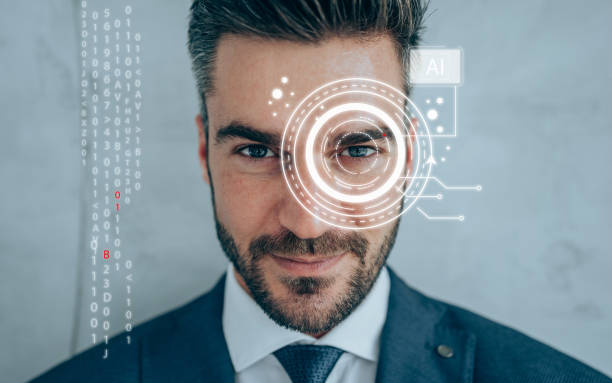
Security biometric retina scanner on man's eye. Artificial intelligence concept.
The struggle of identifying and verifying the interwoven corporate landscape persists. To meet the compliance requirements and reduce the risks of financial crimes, regular audits ensure a system of transparency. A clear picture of the whole company structure involves gathering essential information about its individuals, their activities, and financial records. An organization can avoid legal procedures if its ultimate beneficial owners follow standard regulations. However, UBO verification comes with various challenges that often disrupt the business verification procedure. This blog highlights different problems of UBO identification and the solutions that can help companies overcome them.
Who is an Ultimate Beneficial Owner?
An individual who has the power to control the significant activities in a specific organization. Based on the jurisdiction, the criteria of Ultimate Beneficial Owners can vary. Hence it is crucial for firms to stay vigilant to the state regulations, ensuring complete compliance. Identifying the UBOs is usually very complex. This is because a corporate structure is multilayered, and obtaining reliable information requires thorough background checks. Enhanced Due Diligence (EDD) verifies the entities and individuals who have a major influence over the company’s activities.
Understanding UBO Verification
Before discussing the hurdles of UBO identification and verification, let us understand its importance. UBO verification is the procedure that goes one step deeper than shareholders. Most businesses tend to overlook this step, not knowing that the persons hidden behind multiple layers of the corporate framework could be a red flag. UBO verification analyzes the chains of ownership, uncovering the activities of the UBOs. KYB verification then confirms the legitimacy of the organization and its people, ensuring that they are not a part of money laundering, theft, fraud, and terrorism financing.
The process of UBO verification mainly involves gathering the essential data of the beneficial owners. This may include:
- UBO names
- Dates of Birth
- Nationalities
- Percentage and status of their ownership
As soon as the regulatory body collects this data, it then verifies it against different databases, such as public and government registries, watchlists, and sanction lists, as well as private data sources. Verifying the UBO data against various data sources ensures the accuracy of every stakeholder.
The Significance of UBO Verification
Regulatory structures such as the Anti-Money Laundering Directives (AMLD) in the European Union (EU) and the Financial Action Task Force (FATF) in the United States make it obligatory for businesses to disclose their ultimate beneficial owners. Compliance with these standards helps firms avoid significant fines, legal penalties, and reputational damage while also ensuring they are not accidentally engaging with entities involved in any illegal or criminal behavior.
Knowing who the genuine people behind a company are allows them to make better decisions, lowering the danger of doing business with doubtful or fraudulent businesses. This transparency secures both the company and its stakeholders, which include investors, partners, and clients. UBO verification is also important in establishing transparency and a trustworthy corporate environment since it increases confidence in the company’s operations and governance.
Key Challenges in UBO Identification
In the past few years, transparency regarding ultimate beneficial ownership has acquired significant support on the international regulatory level. However, this domain still lags at some point and needs improvement. Advanced KYB procedures can reduce the risks of unverified UBOs.
Unclear Corporate Structure
Ultimate beneficial owners frequently conceal their identities due to fraud. Whether they are laundering money or offering or collecting bribes, the true leaders of these organizations are determined to keep their names hidden. They may, as a result, make it as difficult as they can to track their money, such as by routing it via a dozen shell firms.
Changes in Regulations
Only lately have laws pertaining to ultimate beneficial owners been created. To promote financial transparency, the Fourth Money Laundering Directive (4AMLD, 2015) and the Money Laundering Regulations 2017 (MLR2017) were passed. Regulated companies run the risk of breaking the law if they are not fully aware of these modifications or the customer due diligence checklist that was implemented in the US in 2018.
Incomplete UBO Data
Legal records of the corporations may vary from country to country, posing a new challenge to the regulatory authorities. Sometimes, when UBOs register themselves, they do not provide complete and accurate data, resulting in obscurity. In such cases, you can not rely on the available data.
Not Updated Data
Another challenge with UBO verifications is the need for updated data to be available more frequently. Ownership of an organization continuously changes. This calls for regular updating and reviewing, which requires advanced data management.
Solutions That Make UBO Identification Easy
The process of UBO identification can be more efficient and simplified with different solutions. These solutions include:
- Centralized UBO register
- Standard UBO reporting method
- Incorporating technology
The Bottom Line
Ensuring complete transparency in the UBO structure is not easy however by opting for the best Know Your Business verification checks, organizations can achieve UBO identification, minimizing the risks associated with noncompliance. UBO identification is the essential component of every business compliance strategy. By devising proper solutions to the UBO identification problems, companies can ensure complete compliance of their owners.







